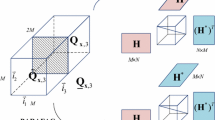Abstract
Communication signals such as multiple constellation signals have complex waveforms and may have multipath source reflection and noncircularity problems. Tensor based source separation techniques have become increasingly popular for various applications as they exploit different inherent diversities of the sources. In this paper, a tensor based convolutive source separation algorithm is developed based on PARAFAC2. The optimisation technique is based on the direct model fitting of PARAFAC and augmented statistics. The proposed method is evaluated using simulated data with multiple pathways and various noncircularity levels. Simulation results confirm the superiority of the proposed method over the existing popular techniques.
Access this chapter
Tax calculation will be finalised at checkout
Purchases are for personal use only
Similar content being viewed by others
References
Bingham, E., Hyvärinen, A.: A fast fixed-point algorithm for independent component analysis of complex valued signals. J. Neural Syst. 10(01), 1–8 (2000)
Bro, R., Kiers, H.A.: A new efficient method for determining the number of components in parafac models. J. Chemometrics 17(5), 274–286 (2003)
Carroll, J.D., Chang, J.J.: Analysis of individual differences in multidimensional scaling via an N-way generalization of ‘Eckart-Young’ decomposition. Psychometrika 35(3), 283–319 (1970)
Cheong Took, C., Mandic, D.P.: Augmented second-order statistics of quaternion random signals. Signal Process. 91(2), 214–224 (2011)
Comon, P.: Tensor decompositions, state of the art and applications (2009). arXiv preprint arXiv:0905.0454
Douglas, S.C.: Fixed-point algorithms for the blind separation of arbitrary complex-valued non-gaussian signal mixtures. EURASIP 2007, 83 (2007)
Green, B.F.: The orthogonal approximation of an oblique structure in factor analysis. Psychometrika 17(4), 429–440 (1952)
Harshman, R.A.: Foundations of the PARAFAC procedure: models and conditions for an explanatory multimodal factor analysis. UCLA Working Pap. Phonetics 16, 1–84 (1970)
Huang, L.K., Manikas, A.: Blind single-user array receiver for MAI cancellation in multipath fading DS-CDMA channels. EUSIPCO Proc. 2, 647–650 (2000)
Javidi, S., Took, C.C., Mandic, D.P.: Fast independent component analysis algorithm for quaternion valued signals. IEEE Trans. Neural Network. 22(12), 1967–1978 (2011)
Kawamoto, M., Matsuoka, K., Ohnishi, N.: A method of blind separation for convolved non-stationary signals. Neurocomputing 22(1), 157–171 (1998)
Kiers, H.A., Ten Berge, J.M., Bro, R.: PARAFAC2-Part I: a direct fitting algorithm for the PARAFAC2 model. J. Chemometrics 13(3–4), 275–294 (1999)
Kolda, T.G., Bader, B.W.: Tensor decompositions and applications. SIAM Rev. 51(3), 455–500 (2009)
Mandic, D.P., Goh, V.S.L.: Complex Valued Nonlinear Adaptive Filters: Noncircularity, Widely Linear and Neural Models, vol. 59. Wiley, New York (2009)
Murata, N., Ikeda, S., Ziehe, A.: An approach to blind source separation based on temporal structure of speech signals. Neurocomputing 41(1), 1–24 (2001)
Nazarpour, K., Praamstra, P., Miall, R., Sanei, S.: Steady-state movement related potentials for BCI an exploratory approach in the STF domain. In: Proceedings of BCI (2008)
Novey, M., Adali, T.: On extending the complex fastica algorithm to noncircular sources. IEEE Trans. Sig. Process. 56(5), 2148–2154 (2008)
Ollila, E.: On the circularity of a complex random variable. IEEE Sig. Process. Lett. 15, 841–844 (2008)
Parra, L., Spence, C.: Convolutive blind separation of non-stationary sources. IEEE Trans. Speech Audio Process. 8(3), 320–327 (2000)
Pedersen, M.S., Larsen, J., Kjems, U., Parra, L.C.: A survey of convolutive blind source separation methods. Multichannel Speech Process, 1065–1084 (2007)
Wee, H., Principe, J.: A criterion for BSS based on simultaneous diagonalization of time correlation matrices. In: NNSP, vol. 97, pp. 496–508 (1997)
Author information
Authors and Affiliations
Corresponding author
Editor information
Editors and Affiliations
Rights and permissions
Copyright information
© 2015 Springer International Publishing Switzerland
About this paper
Cite this paper
Kouchaki, S., Sanei, S. (2015). Tensor Factorisation Approach for Separation of Convolutive Complex Communication Signals. In: Vincent, E., Yeredor, A., Koldovský, Z., Tichavský, P. (eds) Latent Variable Analysis and Signal Separation. LVA/ICA 2015. Lecture Notes in Computer Science(), vol 9237. Springer, Cham. https://doi.org/10.1007/978-3-319-22482-4_7
Download citation
DOI: https://doi.org/10.1007/978-3-319-22482-4_7
Published:
Publisher Name: Springer, Cham
Print ISBN: 978-3-319-22481-7
Online ISBN: 978-3-319-22482-4
eBook Packages: Computer ScienceComputer Science (R0)




